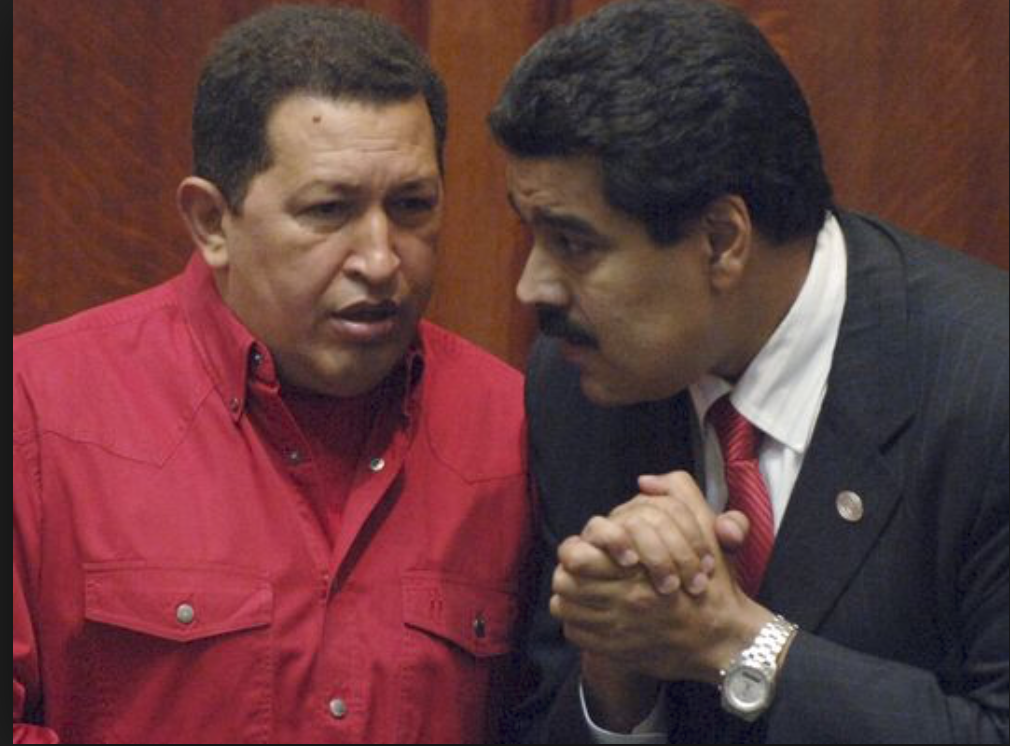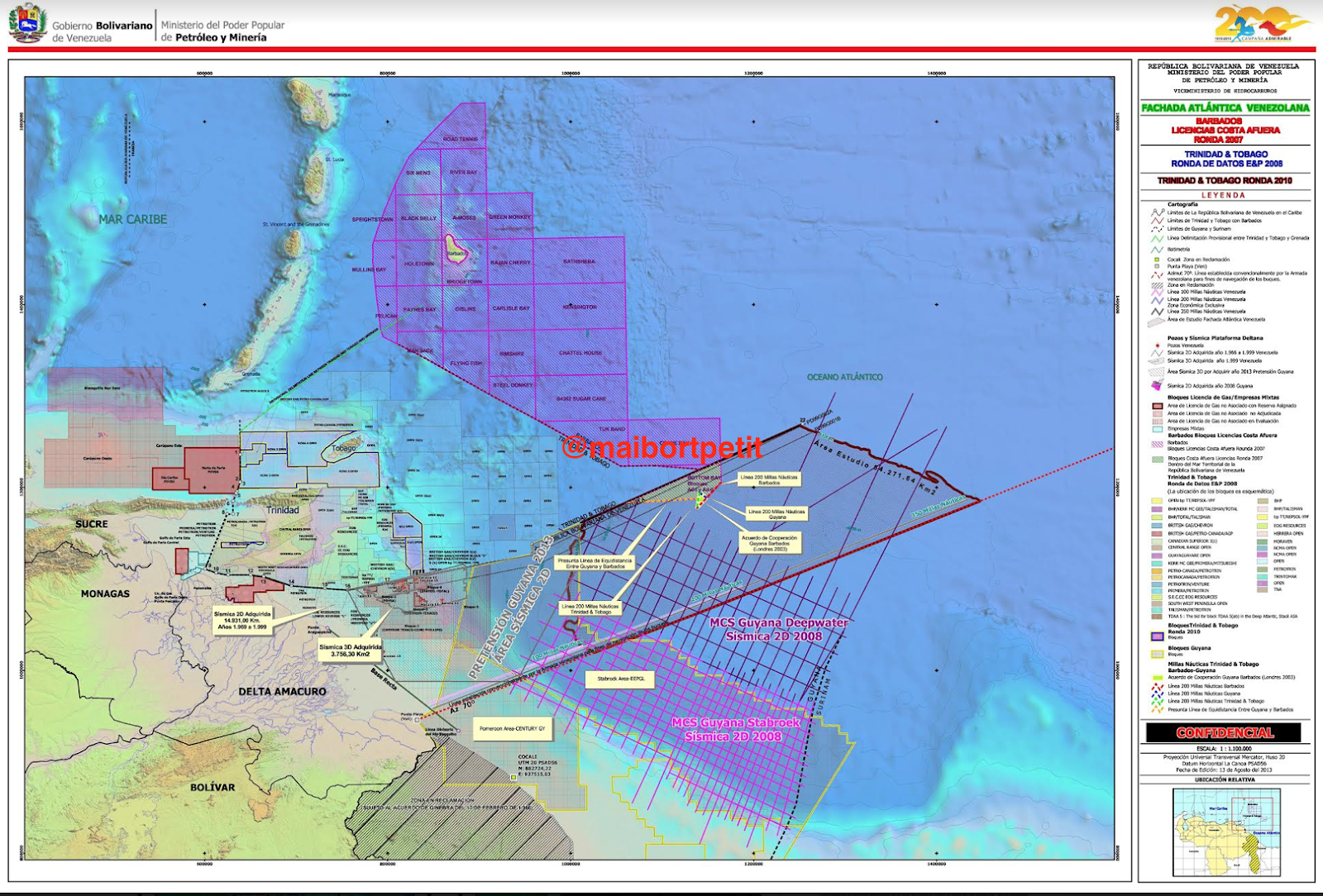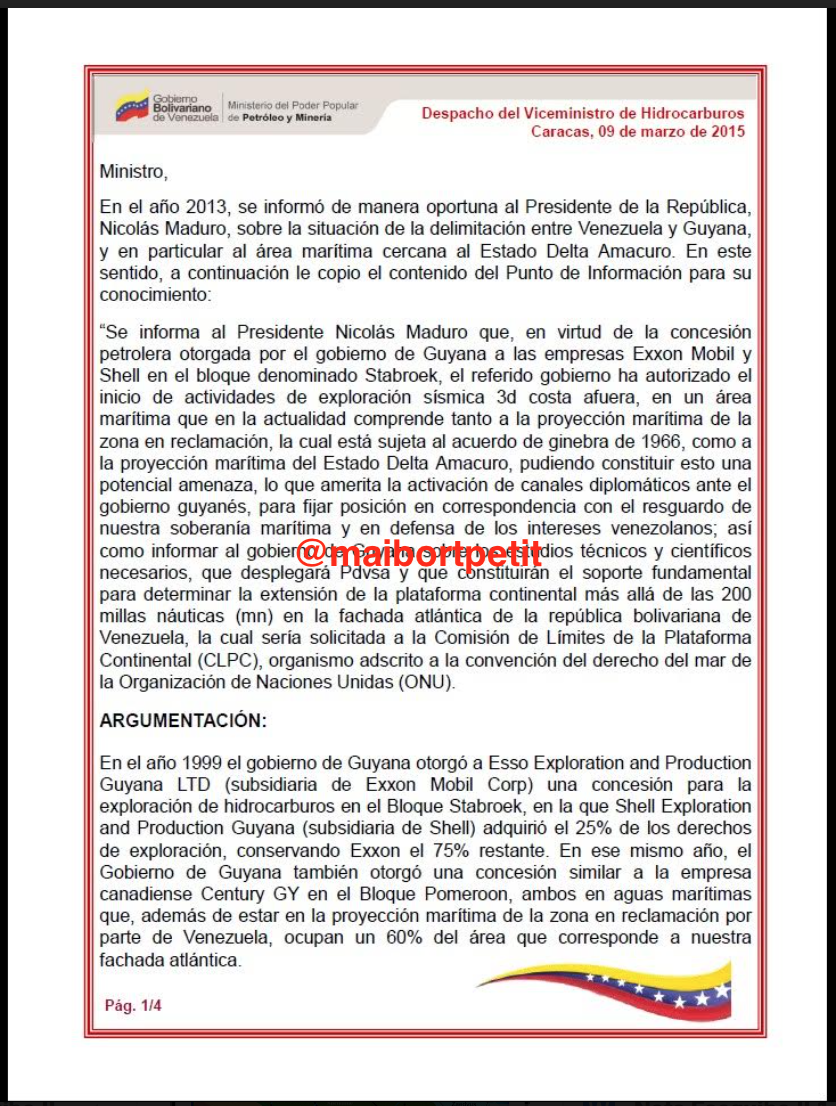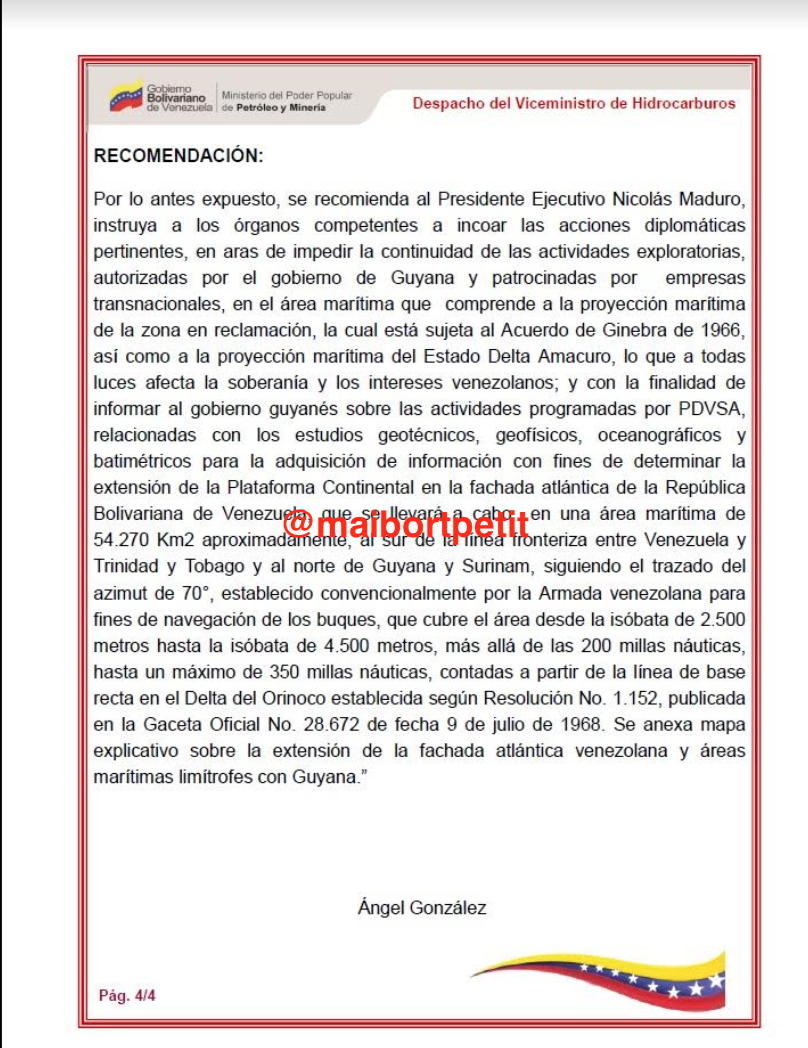By Maibort Petit
@maibortpetit
Beyond the political rhetoric, a series of documents prove that the two Chavista administrations had full knowledge of the activities carried out by the Guyanese government in the area in question. Even in the maritime projection of the Delta Amacuro state, neither acted in defense of the interests of Venezuela.
The late former president, Hugo Chavez, as his successor in office, Nicolás Maduro, could become responsible for the republic losing the territory of the Essequibo – or Guayana Esequiba – given the ineptitude, negligence and even the indifference despite all the signals and alarms that on several occasions warned of the definitive loss of what is known as the area in claim. This is proven by various documents of which we have knowledge.
The Chavez administration was duly informed of all the actions undertaken by the Guyanese government that threatened the Venezuelan sovereignty in the territory of the Essequibo and in the territorial sea, the area of the maritime projection of the area in protest and the projection maritime of the state Delta Amacuro. They not only choose to do nothing to stop this situation, but also promoted a position that was interpreted as a defense to the pretensions of the neighboring claims on the territory and the Atlantic facade which had always been claimed by Venezuela. The Minister of Foreign Affairs and also executive vice president ,at that time and presently the current president, Nicolas Maduro, was alerted. Maduro has neither in the past or present taken a firm stand and as a result it is emerging as the consolidation of the largest territorial dispossession that Venezuela has suffered in all its history.
The documents in question also prove the erratic decisions and positions, adopted by the governments of Chavez and Maduro, denounced on multiple occasions by experts in the field who have risen to warn about the mistakes made by the Chavez administrations in the claim process.
The warning from Ramírez to Maduro
On February 21, 2013, when Nicolas Maduro was executive vice president, he received an account point in which Rafael Ramirez, then Minister of Popular Power of Petroleum and Mining, informed him that the oil concession that the government of Guyana granted Exxon Mobil and Shell companies in the so-called Stabroek block for these companies to start offshore 3D seismic exploration work. It comprised not only the area of the maritime projection of the area under claim subject to the 1966 Geneva Accord, but also the maritime projection of the Delta Amacuro state.
On that occasion, Ramirez alerted Maduro that such a fact merited the activation of the diplomatic channels before the Guyanese government. This was necessary, in order to establish a position in correspondence with the protection of the Venezuelan maritime sovereignty and the defense of the interests of the nation.
He recommended the need to inform Guyana about the geotechnical, geophysical, oceanographic and bathymetric studies that he was preparing to deploy Petroleos de Venezuela S.A. (PDVSA) in order to obtain the necessary technical data that would allow it to request from the Commission on the Limits of the Continental Shelf, attached to the Right to the Sea Convention of the United Nations (UN), the official determination of the extension of the continental shelf of the Atlantic facade of Venezuela.
Rafael Ramirez reminded Nicolas Maduro that in 1999 the Guyanese government granted the company Esso Exploration and Production Guyana LTD, a subsidiary of the US company Exxon Mobil Corp, a concession for the exploration of hydrocarbons in the Stabroek Block.Included in this concession, Shell Exploration and Production Guyana acquired 25 percent of exploration rights, with Exxon retaining the remaining 75 percent. Likewise, for the same date, the Guyanese administration gave a similar concession to the Canadian company Century GY in the Pomeroon Block. Both planned for operations in maritime waters located in the maritime projection of the area claimed by Venezuela and occupy 60 percent of the area that corresponds to the Venezuelan Atlantic facade. These facts were protested diplomatically by Venezuela, while it was denounced before the World Petroleum Council in the years 2000 and 2002, strongly objecting the exploratory works in that area.
The holder of the oil portfolio at that time referred to the warning made by the Ministry of Natural Resources of Guyana to the fishermen and sailors,so that proper precautions could be taken before the 3D seismic exploration activities to be carried out offshore Guyana between January 20 and mid-March 2013. The Guyanese law office reported on that occasion that the oil exploration on the Atlantic side was part of Guyana’s concessions policy, which has a double connotation, the attraction of foreign investment in the economic aspect and the exercise of sovereignty in a maritime space generated by the Essequibo Territory in dispute with Venezuela, in the political sphere.
Ramirez explained to Maduro that Guyana’s strategy was aimed at creating de facto conditions that favored the request for the extension of its continental shelf to the Commission on the Limits of the Continental Shelf in 2009. It would also further Guyana’s position in the Essequibo claim through the participation of third states in the concessions for the exploitation of resources in spaces in claim.
Given the persistent risk and threat of extending its continental shelf affecting Venezuelan sovereign rights on the Atlantic front, Ramirez said that precise and timely knowledge of the limit of the Extended Continental Shelf of Venezuela was a priority and fundamental in order to strengthen the exercise of the sovereignty in the Atlantic Ocean, with the possibility of identifying prospective zones for the exploitation of hydrocarbons. He informed that his office had included in the portfolio of Major Projects of the Hydrocarbons Sector Plan 2013-2019, that PDVSA execute studies for the acquisition of information to determine the extension of the continental shelf. He said that the results of the studies would provide the technical and legal basis to support before the Commission on the Limits of the Continental Shelf the official pronouncement on the extension of the Continental Shelf of the Bolivarian Republic of Venezuela.
He further recommended that Maduro instruct the competent bodies to initiate the pertinent diplomatic actions to prevent the continuation of the exploratory activities authorized by Guyana and sponsored by transnational companies, in the maritime area that includes the maritime projection of the area in claim that it is subject to the Geneva Agreement of 1966, as well as to the maritime projection of the Delta Amacuro state.
Ramirez underscored the importance of informing the Guyanese government about the activities programmed by PDVSA related to geotechnical, geophysical, oceanographic and bathymetric studies for the acquisition of information in order to determine the extension of the Continental Platform on the Atlantic side of Venezuela, to be developed in a maritime area of approximately 54,270 km2, south of the border line between Venezuela and Trinidad and Tobago and north of Guyana and Suriname.
The reminder to Asdrúbal Chávez
On March 9, 2015, from the Office of the Deputy Minister of Hydrocarbons, Angel Gonzalez, a document was sent to the head of the Ministry, Asdrubal Chavez.The note was to remind him that in 2013 the President of the Republic, Nicolas Maduro, was informed in a timely manner, on the situation of the delimitation between Venezuela and Guyana. Specifically, it was alerted to the maritime area near the state of Delta Amacuro as a result of the granting by the Guyanese government of a concession to the companies Exxon Mobil and Shell in the block called Stabroek for 3D seismic exploration offshore in the area that includes the maritime projection of the area in claim subject to the Geneva agreement of 1966, as well as the maritime projection of the Delta Amacuro State, as already indicated above.
At that time Maduro was told that such a situation could constitute a potential threat, for which diplomatic channels should be activated before the Guyanese government, to establish a position regarding the safeguarding of maritime sovereignty and in defense of Venezuelan interests.
Likewise, it was urged to inform Guyana about the necessary technical and scientific studies that PDVSA would deploy and which will constitute the fundamental support to determine the extension of the continental shelf beyond the 200 nautical miles on the Atlantic side of Venezuela, which would be requested to the Commission of Limits of the Continental Shelf (CLPC) attached to the UN.
Asdrubal Chavez was exposed -as Nicolas Maduro had been referred to in his opportunity- that in 1999 the government of Guyana granted Esso Exploration and Production Guyana LTD a concession for the exploration of hydrocarbons in the Stabroek Block in which the Shell’s subsidiary company acquired 25 percent of exploration rights, with Exxon retaining the remaining 75 percent. He was also told that on the same date, the Guyanese government granted another similar concession to the Canadian company Century GY in the Pomeroon Block. These two concessions were made on waters belonging to the maritime projection of the area in claim by Venezuela, which occupy 60 percent of the area that corresponds to the Venezuelan Atlantic facade.
The minister was informed of a summary of the Venezuelan claim on the Essequibo territory. The summary specified the various actions undertaken by the government, including the complaint to the World Petroleum Council in 2000 and 2002. This complaint objected to the exploratory work in that area and the repeated actions of Guyana that contravene the rules that apply in situations in which a territorial claim is in force, such as the one proposed in the case between Venezuela and Guyana. This is because the Guyanese strategy revolves around creating de facto conditions that favor their position in the claim for the Essequibo Territory.
In the same way, he was informed that Trinidad and Tobago, Surinam and Barbados gave the CLPC the technical, scientific and legal information to request the extension of their respective Continental Platforms, which was protested by the Venezuelan Foreign Ministry. In addition, he was told that Barbados began a bidding round for the exploration of hydrocarbons in 26 offshore blocks that occupied Venezuelan territorial waters in 2008, a fact that was also protested by the Venezuelan government.
Estimating that the risk persists and latent threat on the part of the indicated countries of wanting to extend their respective continental platforms in affectation of the Venezuelan sovereign rights in the Atlantic Facade, it became imperative to know exactly and with precision the limit of the Extended Continental Shelf of Venezuela .
For the sake of the latter, he said that the Ministry of Popular Power of Oil and Mining included in the portfolio of Major Projects of the Hydrocarbons Sector Plan 2013-2019, the execution, by PDVSA of the Studies for the Acquisition of Information for Determine the Extension of the Continental Platform as a priority.
The Minister was informed of the recommendations that had been made to President Nicolas Maduro and to which we have already referred in the preceding lines.
Chancellors meeting in 2015
On April 13, 2015, from the office of the minister of the People’s Power of Petroleum and Mining, Asdrubal Chavez, a note subscribed by the Deputy Minister of Hydrocarbons, Angel Gonzalez, was sent to the president of PDVSA for the time, Eulogio Del Pino.
In said note, the deputy minister, Angel Gonzalez, referred to Asdrubal Chavez who, following his instructions, on March 26, 2015, had accompanied the chancellor, Delcy Rodriguez, to a bilateral meeting with his Guyanese counterpart held in Trinidad and Tobago. Representatives of both nations dealt with the legal, technical and political aspects related to the controversies associated with the border limits between the two countries.
Gonzalez referred to legal issues. The first of these matters being the figure of the Good Officiant chosen and accepted by the parties with the aim of bringing both governments closer in search of a satisfactory solution, as established in the Geneva Agreement signed in 1966.
This responsibility fell to the Jamaican, Norman Girvan, representative of the UN until the date of his death in April 2014. It was agreed at the meeting to maintain this figure and nominate by common agreement the substitute.
The chancelleries of both governments had to coordinate to fulfill this task.
The second of the legal issues, referred to the Geneva Agreement which sought first to settle the claim on the delimitation of land territory, then proceed to make the projection of these limits to the Atlantic facade and, thus, delimit the maritime territory.
The third legal issue pointed to the importance of activating the legal advice of a law firm like Kurtis, with experience in resolving border disputes before international bodies.
The second issue discussed by the representatives of both nations was the technical issues that, as the first point raised the creation of a Technical Committee between both republics whose purpose was the analysis of the delimitation of land and sea areas, with established goals and objectives of clearly and fulfilling a work schedule that would allow obtaining concrete results.
He also reported that Foreign Minister Delcy Rodriguez offered the possibility of PDVSA taking charge of developing the seismic exploration program in the disputed area and not Exxon-Mobil, since the participation of the latter represents a great concern, threat and provocation for Venezuela. imperial.
Finally, the representations of Venezuela and Guyana dealt with the political issues and, thus, in the first place, the concern for the presence of Exxon Mobil in the territorial waters still in protest was ratified.
In the second place, it was made clear that Venezuela does not fear confrontation with the most powerful empire in the world, but it does want to avoid that such situation affects the bilateral relationship.
Finally, the commitment that Venezuela has demonstrated with the region through initiatives such as Petrocaribe and Unasur was recalled with the purpose of strengthening the ties of cooperation and support among sister countries.
Exxon report
There is a report on Exxon Mobil dated July 2015 in which an analysis is made of the company. The anaysis highlights that the indicators of the upstream sector are aligned with the strategies outlined which point to a cycle of intense investments in capital focused, particularly in long-term projects.
The report indicates that even when investments were falling, it was expected that production would increase after three years of decline. 4.3 million barrels per day by 2017 was the expected growth and that this growth rate would be maintained to 2020.
In 2015, Exxon Mobil confirmed its strategy of discipline in long-term investments and warned that the company did not expect a price recovery, but to support the resilience of the recovery of production of shale oil and oil in areas geopolitically volatile.
Exxon Mobil outlined a long term investment strategy based on risk management, operations excellence, investments and cost discipline, greater project execution, portfolio management, and leadership in integration and technology.
The budget estimate for 2015 would be USD 34 billion, that is, a decline of 12 percent compared to USD 38.5 billion in 2014 and 10 percent lower compared to the strategy proposed in the 2014 guidelines.
Among other considerations related to operational performance, production of liquids and gas, resources, major projects, the report foresaw that in terms of exploration, the main plans of Exxon Mobil would be directed, as far as main wells were concerned, to Argentina, Angola, Australia, Papua New Guinea, Kurdistan, Romania, Norway, Canada, Gulf of Mexico, Colombia and Guyana. While new acquisitions pointed to Argentina, Brazil, Gulf of Mexico, Canada, East Coast, USA. Equatorial Guinea, Ivory Coast, North Sea, Romania and Papua New Guinea.
On the exploration project in Guyana at Pozo Liza-1, the report indicates that on May 20, 2015, Exxon Mobil announced the discovery of oil in the same, located in the Stabroek Block in the waters outside a depth of 5,433 meters in 1,743 meters of water. He says that the companies Hess (30%) and Nexen (25%, subsidiary of CNOOC) also participated.
It was suggested that this would be the first crude discovery in the history of Guyana, but it was warned that it would take months to verify the size and commercial potential of the discovery. Even so, it was believed that the well could have a reserve of 350 million barrels that could be exploited through a Production Sharing Contract, which would allow profits at the time of increasing the price of crude oil.
The report states that according to the consulting firm WoodMackenzie, «this new discovery (well) is located in territorial waters that are not in dispute with Venezuela, however a portion of the Stabroek Block extends into the territory in claim for Venezuela.»
Guyana’s oil activities
On July 23, 2015, the Executive Direction of Exploration and Integrated Reservoir Studies attached to the General Management of Exploration of PDVSA, presented a report on the importance of the discovery of the Liza-1 Well of the Stabroek Block located off the coast of Guyana and the Territory in Reclamation of the Essequibo, as well as the exploratory and economic implications that this has for the Atlantic front of Venezuela.
The report gives an account of the two types of hydrocarbon licenses granted by the Government of Guyana, among which mention is made of the oil exploration license and the Oil Production license, which are issued in accordance with the guidelines of the Oil Law No. 3 (1986).
Applications for licenses must be submitted to the Minister of Natural Resources and Environment, through the Geology and Mines Commission of Guyana, and are granted through the analysis of the collections required in the request made by each company, at the discretion of the minister.
So far, the licenses granted by Guyana are referred to the stages prior to oil production, since none of the latter has been issued.
The report mentioned the exploration licenses granted and to be granted in Blocks Costa Afuera of Guyana and Guayana Esequiba. So we have, first of all, in the Coastal Block Corentyne, which is located 100 percent in Territorial Waters of Guyana), granted in August 1998 to the Canadian company CGX Energy with 100 percent participation, covers an area of 6.212 Km2. After having covered several stages, the Guyanese government approved an extension from May 31, 2015 until October 31, 2015, for the beginning of the drilling of the next exploratory well, in order to ensure the time of arrival of the drill to Guyana. In second place is the Costa Afuera Demerara Block, located 100 percent in Territorial Waters of Venezuela in Guayana Esequiba. The block was assigned in January 2001 to Canada’s CGX Energy with 100 percent participation to cover an area of 3,975 km2. This company has, as a majority shareholder, CGX Energy which is the company Pacific Rubiales of Canada. The company reprocessed existing seismic data in the block and identified two prospects that were rated high risk. In February 2013, a new exploration license was negotiated with the government and the company agreed to carry out 1,000 km2 of 3D seismic and drill an exploratory well within the initial period of 4 years. Exploration well drilling planned for the second half of 2016. The Costa Afuera Roraima Block, which is located 90 percent in Territorial Waters of Venezuela and 10 percent in Territorial Waters of Venezuela in Guayana Esequiba, was assigned by Guyana in mid-2012 to the company Anadarko Petroleum. They own 100 percent interest. The block covers an area of 20,000 km2.
Anadarko planned the acquisition in 2013 of new 2D seismic data in the block. In October 2013, when the ship «RV Teknik Perdana» carried out such task, it was stopped by the Venezuelan ocean patrol ship «Yakuana».
The exploration operations have been postponed by Anadarko until there would be a resolution of the boundaries between the two countries.
The Block Afrique Kanuku, located 100 percent in Territorial Waters of Guyana, was awarded in May 2013 to Repsol, which in July of the same year was associated with Tullow Oil (United Kingdom). The block covers an area of 6,525 km2.
In December 2013 the company was extended with the entry of the RWE company (Germany) and the participation in the block was made up of Repsol (Operator) with 40 percent, Tullow with 30 percent participation and RWE with 30 percent participation.
In 2014, the partners acquired 3,157 km2 of 3D seismic and 857 km of 2D seismic. After completing the technical studies, these partners had to determine if they went on to the next phase that included the drilling of an exploratory well. This decision was to be taken at the end of 2015.
Regarding Pozo Liza-1
The exploration license for this well was granted to Exxon Mobil in June 1999 with 100 percent interest. At that time the company was looking for partners. The area of the block is 26,806 km2, placing 67 percent – namely, 17,960 km2 – of the block in the Essequibo. In 2008, the GGMC contracted the company PGS for the multi-customer type 2D survey work. In 2009, Shell entered with 25 percent and in 2012 this participation increased by 25 percent to a total of 50 percent. In March 2013, the partners completed the acquisition of 3D seismic on a part of the block and in 2014 Shell sold its 50 percent, so at the time of issuing the report Exxon Mobil (Operator) had a 45 percent stake. Hess Corporatíon (USA) participated with 30 percent. China National Offshore Oil Company (CNOOC) did so with 25 percent. By March 2015, Esso Exploration and Production Guyana Ltd. (EEPGL) scheduled the start of the drilling of the first well in the Liza prospect with the Deepwater Champion. As a result of this exploratory activity he found 295 feet (90 meters) of net sand with high quality oil. On this the company Exxon reported: «Analyzing data obtained by the well to determine with precision the commercial viability of the prospect and evaluate the potential of resources in the block. There are reasons to be optimistic. » This was Guyana’s first successful offshore discovery.











Actos de traición a la patria indudablemente cometidos.